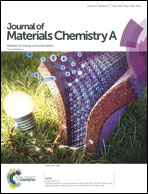Capitalization of interfacial AlON interactions to achieve stable binder-free porous silicon/carbon anodes†
Abstract
Scalable wet chemical etching of porous silicon (PS) has been regarded as a promising method to revolutionize the high-energy-density Si anodes of lithium-ion batteries. However, it forms internal pinholes or nanoscale cracks in the lateral dimension spontaneously, which are the main causes of fractures in growing cracks, especially under repeated volume expansion and shrinkage. In addition, the large inter-particle resistance and poor interaction between the binder and particles of traditional electrode configurations hampers high volume expansion anodes. To improve the structural integrity of PS particles and to construct strong interfacial interactions between the binder and PS, we introduced a new binder-free monolithic electrode structure based on direct encapsulation of PS/Al2O3 particles into cyclized polyacrylonitrile (c-PAN) with covalent aluminum oxynitride (AlON) interfacial interaction to form monolithic, multi-core, crosslinking composite matrices. Al2O3 on the surface was reduced and reacted with the nitrogen atoms in PAN and converted to covalent AlON during heat treatment under an Ar/H2 atmosphere. The small cracks and pinholes formed during etching were reduced by the completely conformal coating of AlON, which enhanced the structural integrity of PS by increasing its fracture resistance. In addition, due to the strong chemical-bond interaction between c-PAN and Al2O3, PS/AlON/c-PAN could enable a highly conductive electron pathway to withstand repeated volume expansion and contraction. Furthermore, AlON increased the charge transfer resistance and prevented electrons from reaching the PS/AlON surface to reduce the electrolyte. The stable materials and durable electron pathway of PS/AlON/c-PAN afforded an excellent cycle life under deep charge/discharge cycling. Furthermore, AlON of different thickness was optimized to improve the kinetics performance. We demonstrated use of PS/AlON/c-PAN as a highly specific charge capacity anode (2062 mA h g−1 based on the total mass with a capacity retention of 89% after 100 cycles) and high performance with long lifecycles (500 cycles with 1015 mA h g−1 capacity retention). This scalable and remarkable material design for PS anodes could also be extended to other high-capacity materials that suffer from huge volume changes.



 Please wait while we load your content...
Please wait while we load your content...